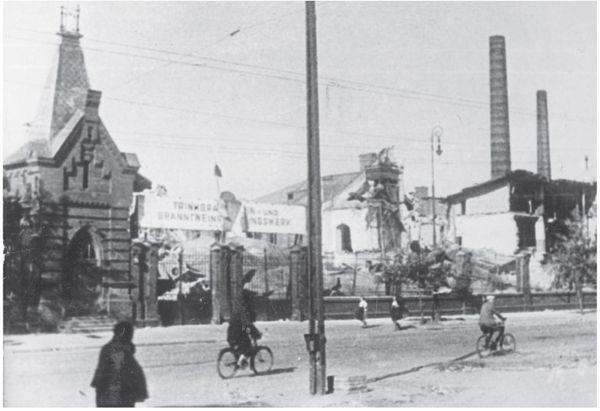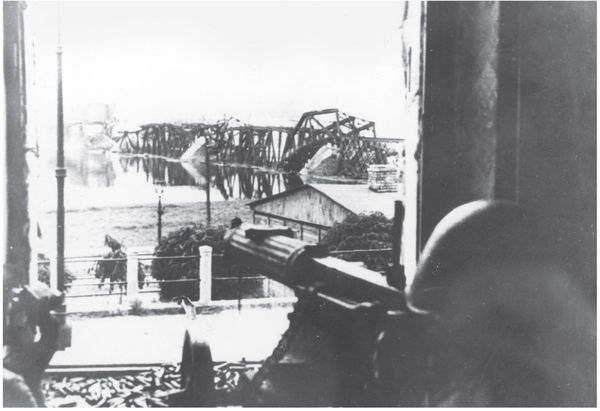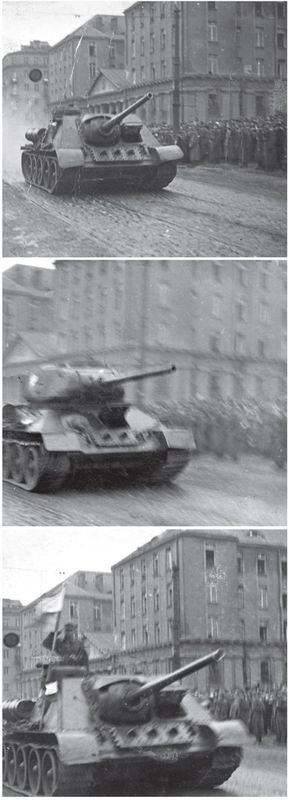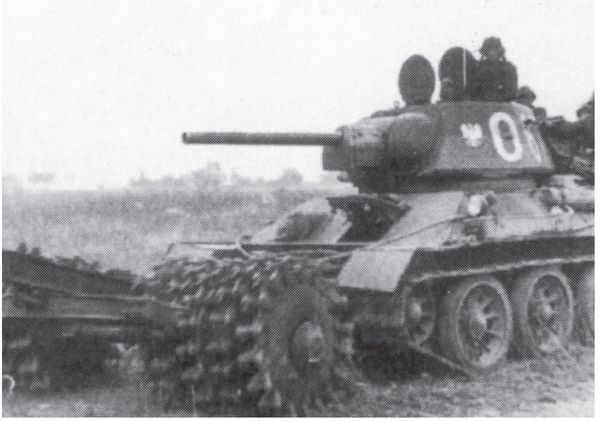Warszawa II (24 page)
Authors: Norbert Bacyk

P
arallel with the 47th and 70th Armies' final combat engagements north of Praga between September 16 and 23, a number of dramatic landings were made by regular Polish troops on Warsaw's western bank. Directly after the front passed through Praga, the WisÅa-sector made ready to greet Major General Zygmunt Berling's 1st Polish Army which was en route to the city. On the evening of September 15, Berling occupied the river bank opposite the city quarters of Marymont and Å»oliborz located west of the river, with the 2nd Infantry Division “Henryk DÄ
browski”; the area around Warsaw's Zoo on the east side opposite the ruins of the Old Town and the New Town, with the 1st Cavalry Brigade; and lastly, in Saska KÄpa on the east side, with the 3rd Infantry Division “Romuald Traugutt.” When the remaining German positions by the ruins of the railway bridge in Praga near Cytadela (GolÄdzinów) had been eliminated, the exhausted Polish 1st Infantry Division, with the exception of an artillery regiment, returned to the army's reserve forces.
On the morning of September 16, under orders from the commander of the 1st Polish Army, preparations were already underway for the 3rd Infantry Division's 9th Infantry Regiment to cross the river to Czerniaków. Unfortunately, this became a fairly chaotic operation. Only the first battalion managed to get across the river as planned â the other two, due to enemy fire, had to make use of the cover of dark and didn't reach Czerniaków until sometime during the nights of September 16 and 17. Despite the soldiers linking up with Lieutenant Colonel “RadosÅaws” Home Army forces, they were seriously hampered by the absence of ammunition deliveries and by poor training in urban warfare. As a result, they suffered heavy losses which only served to prolong Czerników's death struggle. The 9th Regiment was wiped out before September 23 by General Rohr's units and soldiers from the II Panzergrenadier-Regiment 146 from the 25th Panzer-Division. Only some tens of survivors were successfully evacuated during the night to Praga.
The toll was even worse for the 3rd Infantry Division, 8th Regiment's landing between the Central and the Poniatowski Bridges, both of which had been destroyed. The regiment's 1st Battalion began crossing the WisÅa on September the 19, at 1600 hours. Thanks to smoke cover and artillery support, this unit successfully reached the built-up area of the city. But the landing operation was poorly coordinated with respect to planned artillery support, which led to the next battalion having to attempt a successful crossing on rubber floats without any protection. Seeing this, the German artillery opened up with a wall of fire on the river â and at the 2nd Battalion's proposed landing site, a transport carrier, equipped with a machinegun and a rapid-fire 20 mm gun, suddenly cropped up, along with other tracked-vehicles from Fallschirm-Pz.Gren.Rgt. 2 “Hermann Göring.” Soldiers from the Luftwaffe drove back the 1st Battalion and the cover it was attempting to provide from the river bank; and thereafter, proceeded to mow down a large part of the 2nd Battalion in the water. It was only the telling effect of a direct hit from a 7.62 cm gun firing from Praga which forced the German vehicles to retreat from the river bank, thereby saving the lives of around 150 swimming survivors who managed to take themselves up onto the river bank on the Praga side. Meanwhile, the 1st Battalion had been surrounded and after having fought throughout the night, it surrendered. All told, the two Polish battalions lost 370 soldiers and an additional 300 were taken prisoner.
A similar drama was played out in Å»oliborz. On the night of September 17, in the district of Potok, a company out of the 2nd Infantry Division, 6th Regiment, 2nd Battalion landed without taking casualties (serving in the cited regiment was, among others; Lieutenant Wojciech Jaruzelski â the last President of the Peoples Polish Republic.) The following night the rest of the battalion joined the, as yet, undiscovered-by-the-enemy company (the soldiers had hidden in bushes by the bank and the Germans at this point had no troops in the immediate area). That same night another company from the 3rd Battalion crossed the river. These troops made a failed attempt to enter Å»oliborz which was defended by a Lt. Colonel “Family provider” contingent. On September 20, a messenger had just arrived from the battalion to the location of a resistance unit baring a radio transmitter, but by that time the Germans had already cut off the battalion at the WisÅa. General Lüttwitz gave the order that the enemy bridgehead should be eliminated as soon as possible. This resulted in units from the Panzergrenadier-Regiment 146 and the Panzer-Aufklärungs-Abteilung 87 from the 25th Panzer-Division attacking the Polish troops; who lacked heavy weapon support, on the morning of September 21. Despite initial hard-nosed resistance, the commander of the 2nd Infantry Division, General Jan Rotkiewicz, watching from the other side of the river observed: “At 11:00 AM, the sound of the 2nd Battalion, 6th Infantry Regiment's battle quieted and communication was broken.” The Germans took a total of 218 prisoners of war.
Destroyed distilleries on ZÄ
bkowska Street, Praga September 1944. (WAF)

Thus ended the 1st Polish Army's effort to support the Uprising. The final figures reflect a tragic outcome: 1,987 dead or missing, 627 evacuated, of which 289 were wounded (more than at the storming of all of Praga). Marshal Rokossovskij received news of the landing-operation's failure stoically. Objectively, it should not have surprised him. General Berling's army was clearly not capable of single-handedly, i.e. without the assistance of Soviet engineer units, overcoming the obstacles posed by large bodies of water under combat conditions This was also evident at DÄblin and PuÅaway where crossings of the WisÅa were organized in a clumsy fashion. In Warsaw, the disorganization, the useless coordination of the individual units, and the consequent excessive time it took for the troops enter into battle became ever more apparent. The commander of the 1st Belorussian Front never hindered Berling's amphibious operations. He even assisted him by providing a number of boats held in reserve but he did this fully aware that these resources would not be enough to make these operations successful. This was just what Stalin meant when he gave the order to: “Provide the insurgents complete support.” Rokossovskij was only surprised at how quickly Berling had begun the crossing operations â in his view, it bordered on overzealousness. For this very reason, Berling was transferred on October 1 to the post of deputy to the commander of the Polish Army. Formally, the position of deputy commander was a promotion but in December 1944, the general nonetheless resigned his post and travelled back to Moscow.
On the German side, the end of September was characterised by mounting nervousness. The HQ staff of the 9th Army had grossly overestimated the actual Soviet troop strength and the possibilities they had outside Warsaw, plus their commitment to helping the insurgents. Therefore, following the loss of Praga, very well-equipped units from the Wehrmacht had been regularly sent to the capital city and the fighting taking place there. . The Uprising was to be strangled as quickly as possible, for fear there would be further landings across the WisÅa in the very near future. Here, units from the 25th Panzer-Division and Fallschirm-Pz.Gren.Rgt. 2, plus an engineer battalion from the Fallschirm-Panzer-Division “Hermann Göring” were brought into action. For the sake of being more precise, it should also be noted that Panzer-Regiment 9 from the 25th Panzer-Division and Panzergrenadier-Regiment 147 had already been notified in the middle of the month, but had, in fact, never been dispatched from PuÅtusk. Thus, the division fought in Warsaw only with the earlier cited Panzergrenadier-Regiment 146, Panzer-Aufklärungs-Abteilung 25, Panzer-Pionier-Abteilung 87, Flak-Artillerie-Abteilung (motorised) 87, along with artillery from Panzer-Artillerie-Regiment 91. The presence of these units strongly contributed to the defeat of the enemy at Czerniaków and the annihilation of the Polish Army's landing attempts, as well as to the significant weakening of the Home Army, even though heavy losses were sustained. During the first 48 hours of fighting against the resistance soldiers, German losses from the so-called “Family providers” detachment with respect, for example, to the reconnaissance battalion and the engineer troops from the 25th Panzer-Division, were recorded as 110 killed and 220 wounded.
A Polish Maksim machinegun, model 1910, near the destroyed Kierbedż Bridge, September 1944. (WAF)


At the top and bottom tracked SU-85 assault guns from the 13th Tracked Artillery Regiment, in the middle photo â a T-34/85 tank from the 1st Tank Brigade. (WAF)
Between September 21 and 23, the new commander of the 9th Army carried out a number of changes in the grouping of his troop forces. He issued an order to SS-Gruppenführer Gille to regroup the 19th Panzer-Division on the WisÅa's west bank with the XXXXVI Panzer-Corps, and further ordered that the Hungarian 1st Cavalry Division and the remnants of the 73rd Infantry-Division be drawn back to the rearguard. This evident weakening of the momentarily passive IV SS-Panzer-Corps was dictated by an order from Heeresgruppe “Mitte's” command imparting the information that the 25th Panzer-Division was to return to PuÅtusk. The 2nd Army therefore resumed preparations for eliminating the bridgehead there. The Hungarian troops, on the other hand, would, before the month was out, leave all their positions to the disposal of the Germans and be despatched home to Hungary. As it actually happened, this didn't take place until the last half of October. Prior to this, or more precisely, during the last few
days of September, the rest of the 73rd Infantry-Division was attached to the 5th Ersatz-Division outside Warsaw. After two weeks, the Wehrmacht's luckless division was reorganised and the Hungarians were replaced by the 337th Volksgrenadier-Division (this arrived successively: the first to arrive in Konstancin was the 688th Grenadier-Regiment on October 14th). The Germans were able to regroup their formations
“ ... during a period where the enemy was relatively quiet and without combat activity over and above the usual,”
just as Heeresgruppe “Mitte's ” command reported on September 23. These conditions were to prevail on the Warsaw front from that precise day (when the final liquidation of the 1st Polish Army's bridgehead took place) until October 10..

A mine-detector coupled to a Polish T-34-76 model 1942. The tank comes from the Free Polish 1st Army, positioned at Warsaw in September 1944. (Leandoer & Ekholm archive)